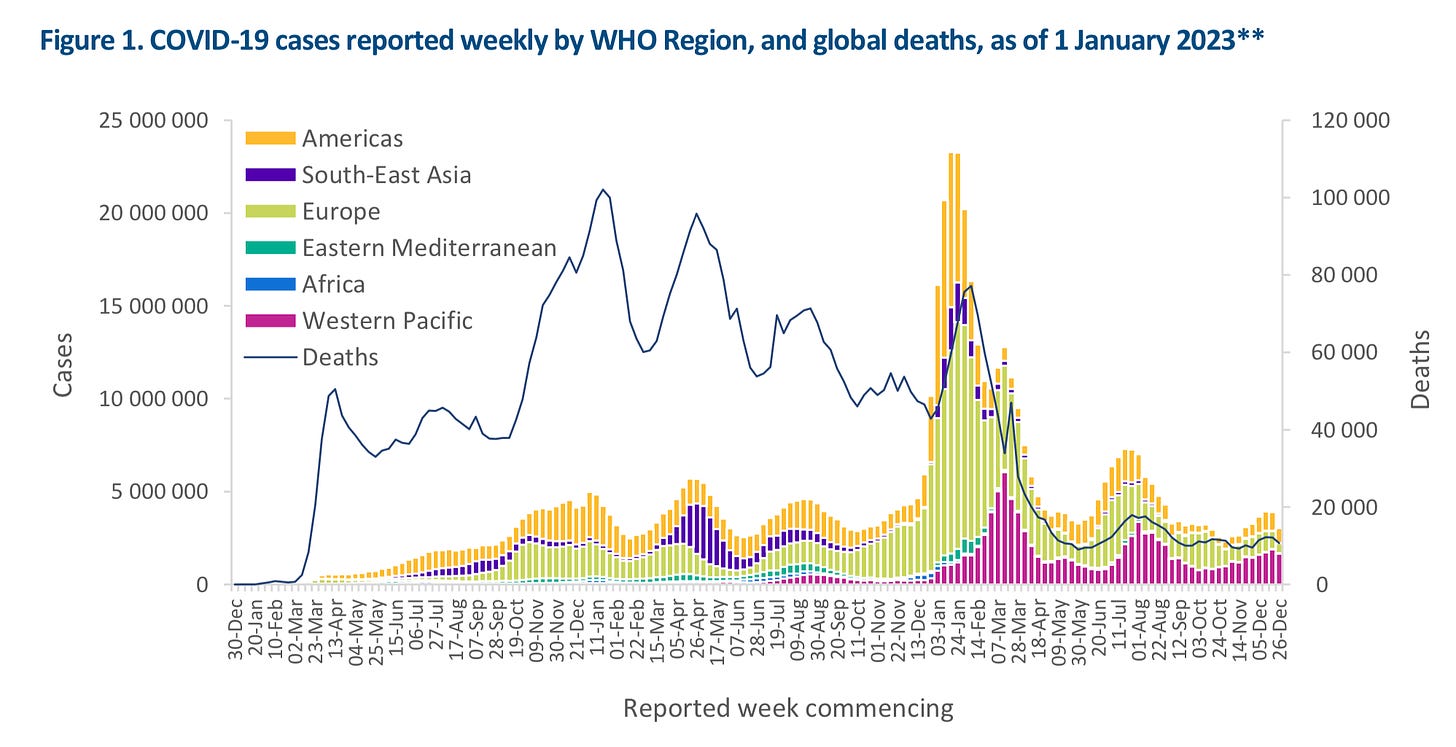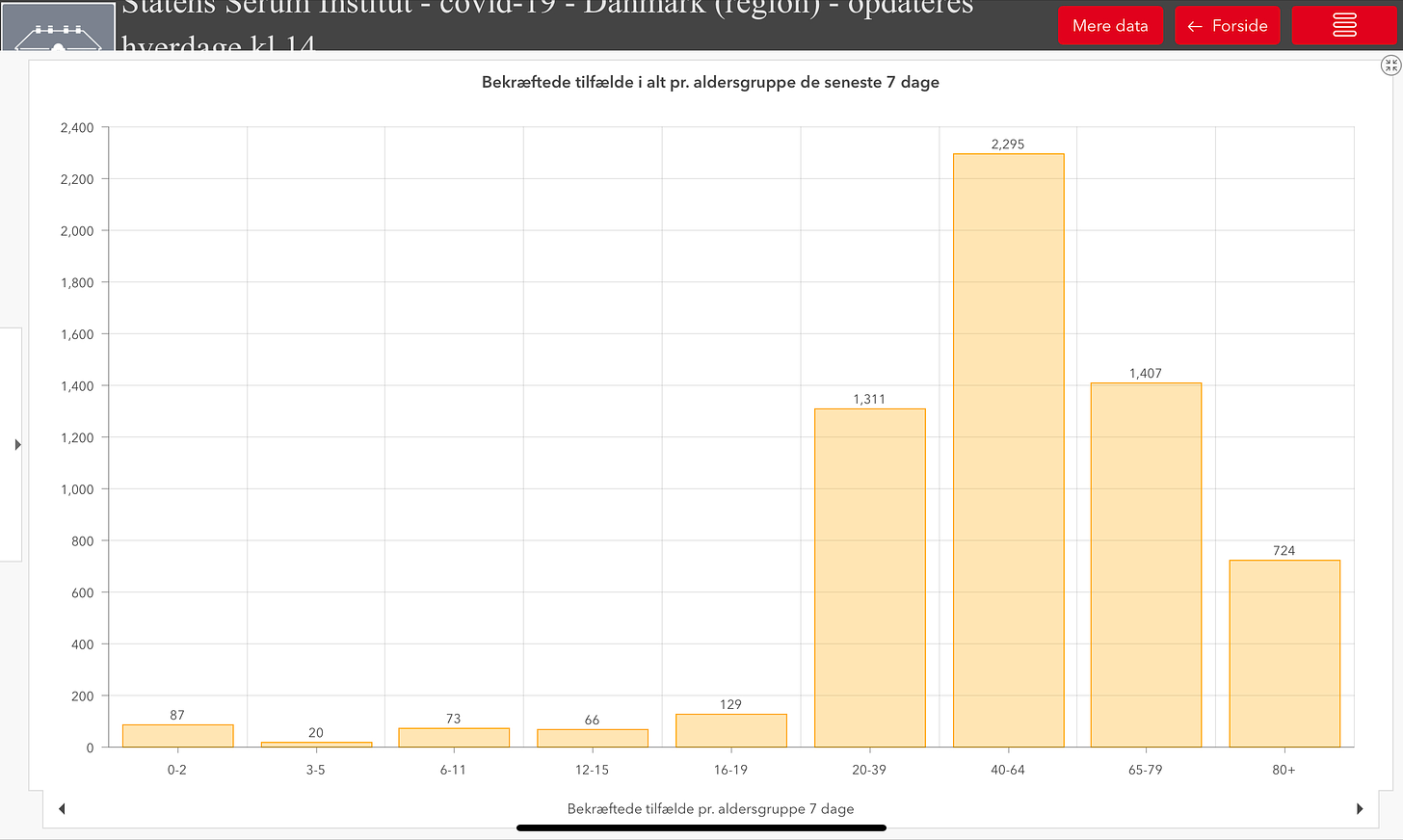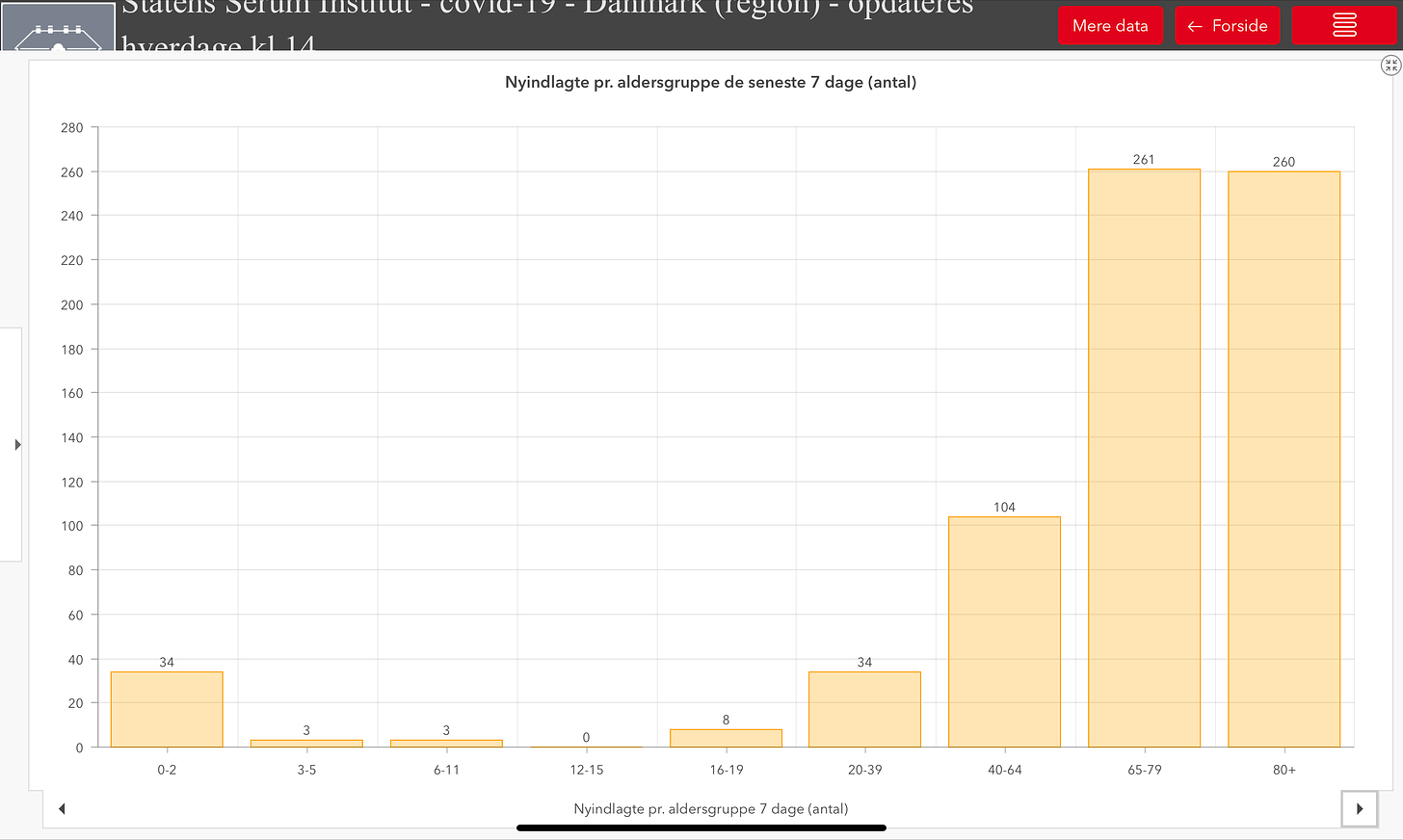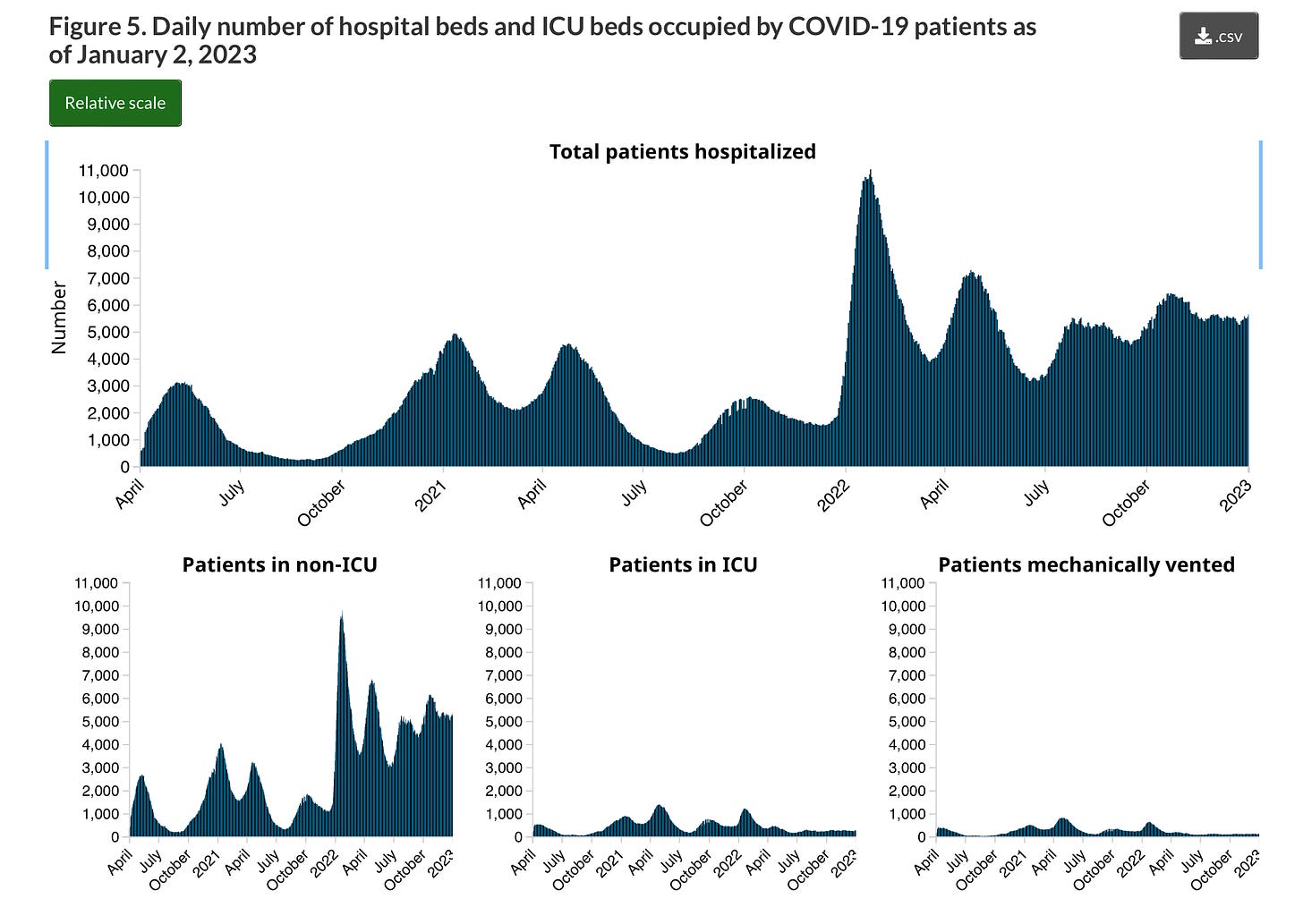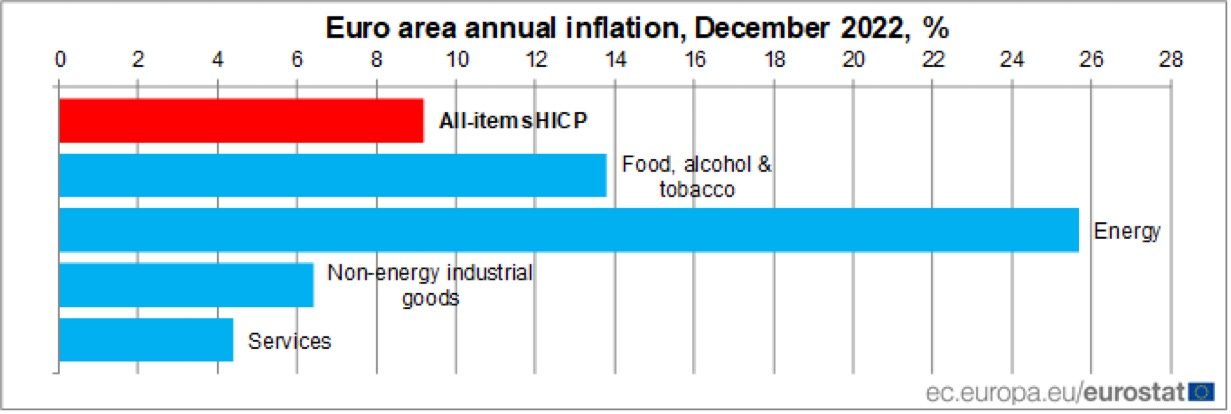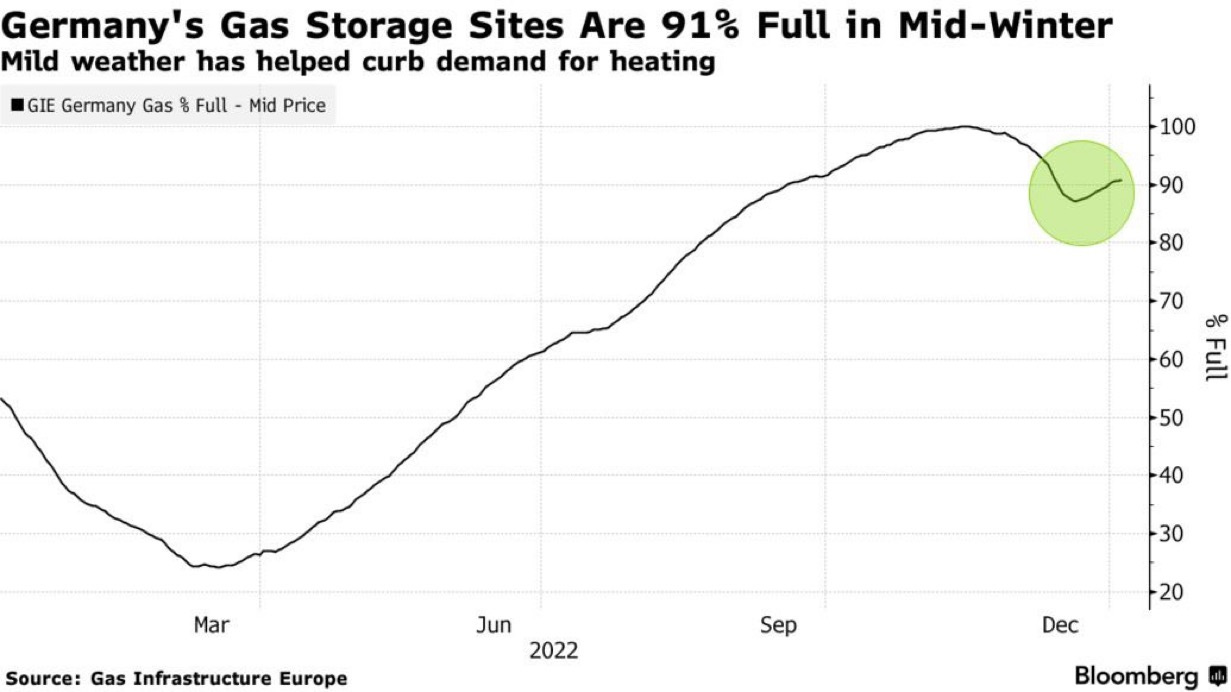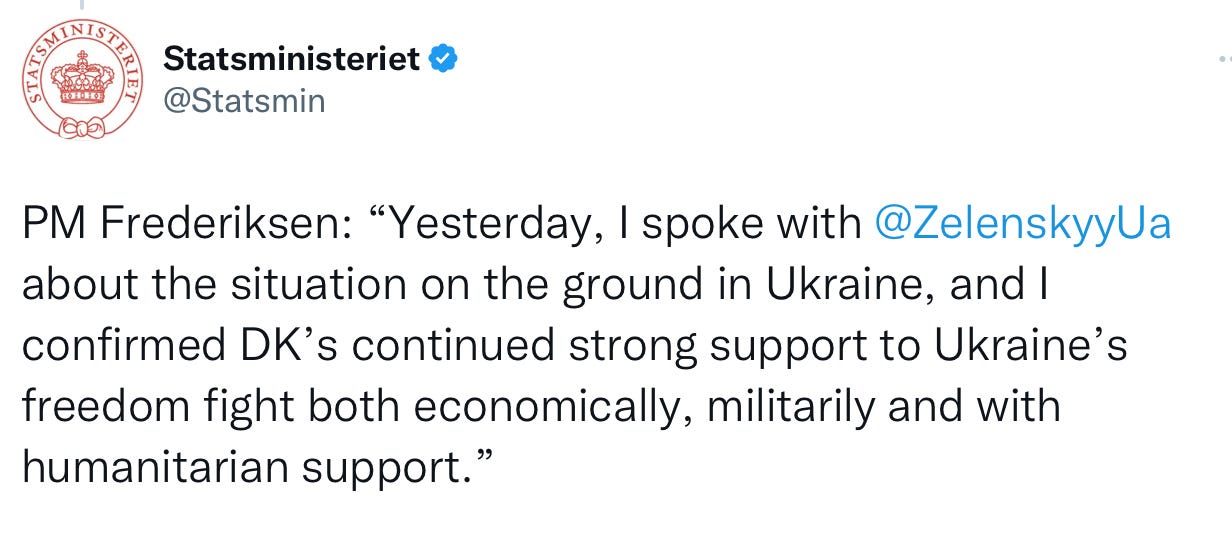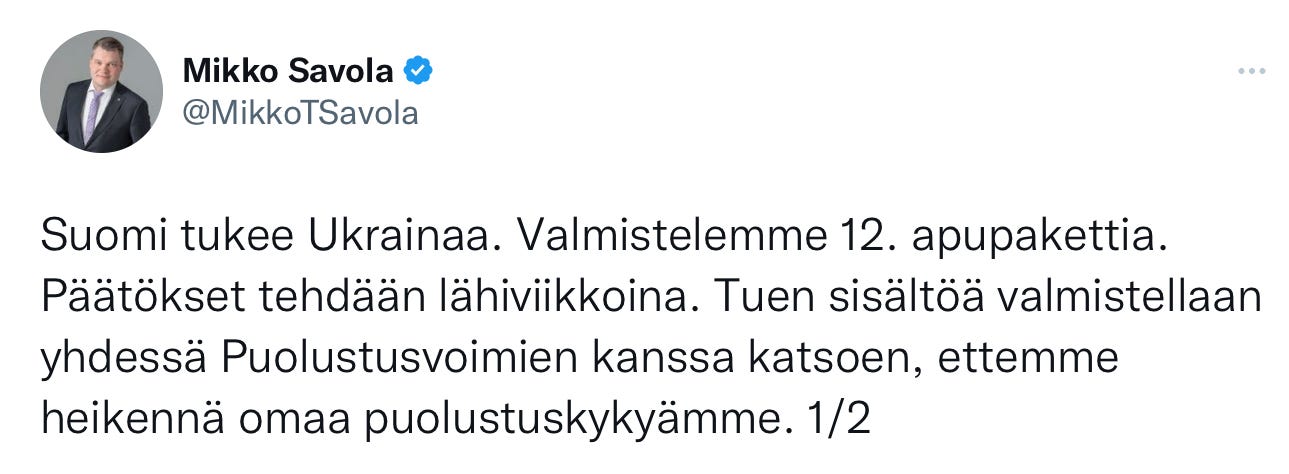Monday Morning News & Notes
Travel restrictions make a return. Respiratory infections strain Swedish hospitals.
🦠Pandemic🦠
🇪🇺🦠
The European Centre for Disease Prevention and Control has put out a very preliminary assessment of the concerning new COVID variant, XBB.1.5. It says while there is “significant uncertainty” the variant is estimated to have a pretty massive growth advantage of 137% over other strains currently circulating in Europe.
“There is a possibility that this variant could have an increasing effect on the number of COVID cases in the EU/EEA, but not within the coming month as the variant is currently only present in the EU/EEA at very low levels.”
With global testing and sequencing numbers at extremely low levels, it is putting a major crimp in efforts to get a better handle on this new variant. The ECDC notes there were, as of January 3, just 3,456 sequenced positive tests involving XBB.1.5. Most of those are from the United States, with a few from the United Kingdom.
The U.S. Centre for Disease Control is reporting that the proportion of XBB.1.5 infections is doubling every nine days. While the WHO warns this is the most contagious coronavirus variant yet, the American CDC has it as having the second highest growth advantage of any variant except for the original Omicron strain.
The variant has also been detected in several other countries including Denmark, France, Austria, Netherlands, Germany, Italy, Spain, Sweden, Iceland, Belgium, Czechia, Portugal, and Ireland.
The ECDC notes:
“This does not necessarily mean that the variant will become dominant in the EU/EEA, since major differences in variant circulation have been observed between North America and Europe several times during the pandemic.”
The agency says a rare mutation in the variant has increased its ability to dodge previous immunity, be it by having had an infection or being vaccinated.
“There is currently not enough information available to assess any change in infection severity associated with the variant.”
WHO 🌎
The latest global pandemic assessment from the World Health Organization points to a very uncertain situation around the globe. There were more than three-million new infections and another 10,000 COVID deaths in the week ending January 1. Week to week infection numbers were down (-22%) as were pandemic deaths (-12%). But, this is where things get a little complicated. If you look at the numbers over the last 28 days there were 14.5 million infections and over 46,000 more lives lost to the virus. That is an increase of 25% and 21% respectively, over the previous 28 day period.
Adding to the uncertainty, the WHO is cautioning that all these numbers need to be taken with a fairly large grain of salt because of extremely low testing numbers and reporting lags due to the holiday season.
“Therefore, data presented in this report, especially for the most recent week, are incomplete and the decreasing trends should be interpreted in that context as they may change with updated information provided following the holiday period.”
Japan again recorded the highest number of new weekly infections with 946,130 (-18%). It is followed by South Korea with 457,745 new cases (-3%), the USA with 393,587 more infections (-21%), and China with 218,019 new COVID infections (+45%).
The United States has again registered the most new weekly pandemic deaths, with another 2,501 Americans losing their lives (-14%). Japan followed with 1,941 deaths (-3%) while China saw 648 deaths (+48%).
*Keep in mind there has been a lot of international criticism about the accuracy of numbers being reported in China. If anything, what we are seeing is likely underreported.
-
Omicron variants of concern accounted for 98.4% of positive tests conducted and then sequenced globally in the month from December 2 to January 2. Of those, BA.5 and its sub-variants accounted for 63.7% of all sequenced positive test results. But, the WHO notes its numbers are in decline. This is because BA.2.75 variant numbers are growing globally, accounting for about 15.2% of submitted sequences.
The global health agency says it is closely monitoring six variants of concern at the moment. They are BQ.1, BA.2.75, BA.4.6, BA.2.3.20, and the XBB strain, and its sub-variant XBB.1.5.
“Based on current evidence, there is no indication of increased severity associated with these variants under monitoring compared to the former Omicron lineages.”
🇩🇰/ 🇨🇳
As of Sunday, China has removed border controls allowing its citizens to travel internationally. But, it doesn’t look like Denmark will be following its Swedish neighbour in placing travel restrictions on visitors arriving from China. Minister of the Interior and Health Sophie Løhde now has an assessment from the Statens Serum Institute on whether any measures should be taken. The SSI has concluded that travelers from China pose no significant infection risk. It says requiring a negative test before boarding a flight to Denmark from China would have a “marginal effect” on the epidemic situation.
In the assessment, the arguments from SSI include, among other things, that Danish public health and epidemic control will not be endangered because there is a high level of population immunity, and that there is no information sparking any concern about new worrying variants in China.
Minister Sophie Løhde:
“I have now received the assessment from the Statens Serum Institut. I have therefore informed the parliamentary parties about SSI's assessment and asked the Epidemic Commission for an advisory assessment. When we have the Epidemic Commission's assessment, we will discuss it with the members of the Epidemic Committee.”
The Epidemic Commission is expected to table its advisory assessment later today.
The SSI assessment comes after a meeting of the EU's crisis response council, which last week, tabled a series of recommendations to EU member states, in which it strongly urged that they require a negative COVID test from travelers arriving from China.
University of Copenhagen Professor of Experimental Virology Allan Randrup Thomsen spoke to DR and agrees with the SSI assessment saying in his view there is currently no evidence contradicting the agency’s conclusions.
“We have good immunity in Denmark. We know the varieties that are currently in China. The number of travelers we receive from China, in relation to the number of cases of infection we already have within the borders, seems to me to be disappearing. But of course things can develop. It's not enough to cause any worry.”
Although China's official corona number is just over 5,000 deaths since covid-19 first appeared, few people are ready to put a blue stamp on those numbers.
Roskilde University Professor of Epidemiology Lone Simonsen also agrees with the institutes assessment, even though the numbers being reported by China are questionable.
“I don't see what testing would do because there simply aren't that many travelers from China. It's not enough to worry about. We can be pretty sure that they have a huge epidemic going on. This can be seen as their hospitals struggle and in connection with burying the dead. But we have a few reports from China which do not indicate that there are any variants that we do not already have in Europe.”
🇩🇰
The Danish Health Authority is ruling out another round of COVID vaccine booster doses this winter for the oldest and most vulnerable. The agency says it is following the slate of respiratory infections closely as coronavirus, RS virus, and influenza sweep through society. It says respiratory infections are behind a high number of hospitalizations, but it stresses that hospital admissions “are not higher than what is normally seen in a winter season.” The health authority says RS virus admissions have fallen, but COVID and influenza hospitalizations are rising.
Last week, the Statens Serum Institute said that COVID deaths had risen dramatically, especially among seniors over the age of 75. Despite that, Sundhedsstyrelsen says that vaccine effectiveness at protecting against severe infections, hospitalization, and death is “still very good.”
“At present, therefore, there are no signs of declining protection and a need for more vaccinations.”
Preparedness and Infectious Disease Unit Head Line Raahauge Hvass:
“If you are worried about infecting an elderly family member, follow our infection prevention advice: Stay at home if you are sick, go outside, wash your hands, cough into your sleeve and do extra cleaning. You can also wear a mask if, for example, you are going to visit an elderly or infirm person and are worried about coughing a little.”
The health agency recommends that seniors and those in high-risk populations stock up on self-testing kits.
“For vulnerable and high-risk groups, COVID pill treatments may be recommended. The treatment must be started no later than 5 days after symptoms appear, so there is not much time to waste. Therefore, it is a good idea to have a self-test lying around at home if you are in the target group for early treatment. This means that you can quickly find out whether you have COVID and get in touch with your doctor, who will assess whether you should have the tablet treatment.”
For people at risk who do test positive, the Danish Health Authority says they must meet certain criteria to get early treatment with pill-based COVID care, for example using Pfizer’s Paxlovid pill.
Among the criteria is having significant COVID symptoms that have lasted a maximum of five days.
The risk groups for severe coronavirus infections are:
You are 80 years or older and were vaccinated more than 6 months ago.
You are 80 years of age or older and have one or more chronic diseases or conditions⁎, regardless of your vaccination status.
You are 65-79 years old and unvaccinated.
You are 65-79 years old, have one or more chronic diseases or conditions, and were vaccinated more than 6 months ago.
You are 50-64 years old, have one or more chronic diseases or conditions, and are unvaccinated
You are pregnant and are at increased risk, for example, due to chronic diseases, and have not been vaccinated. It is up to a person’s doctor to assess whether they are at increased risk.
-
Over the last seven days in Denmark, infection activity was highest among those 40 to 64 years old but the lions share of all coronavirus cases were solidly concentrated in the age groups from 20 to 79. There were a concerning 87 infections among infants.
-
74% of all COVID-related hospitalizations in the last week were among seniors over the age of 65. While 5% of admissions were infants.
-
Denmark’s farmed mink industry is getting ready to rebuild from scratch. The first shipment of new breeding mink will arrive in the country next week, according to the industry association, Danske Mink.
Denmark’s entire farmed mink population was wiped out in the winter of 2020 when mink began being infected with COVID and then passing what was at the time called the Mink variant on to humans. Millions of farmed mink were culled literally wiping the entIre industry out. This would later evolve into a political scandal that is still haunting the Mette Frederiksen government.
🇸🇪
The Swedish Public Health Agency reports it COVID statistics once a week every Thursday afternoon.
-
As Sweden grapples with three different infection waves, the hospitals in its capital region are straining under huge pressure. Five out of six emergency hospitals in Region Stockholm (Södersjukhuset, Norrtälje hospital, Södertälje hospital, Capio St. Göran hospital, and Danderyd hospital) have been in emergency staffing mode since Christmas week.
The region says hospitals are inundated with patients battling COVID, influenza, or RS virus infections. The situation is being made worse by the number of healthcare staff being who are also getting infected and having to call in sick.
Chief Physician Johan Bratt:
“The hospitals have prepared for a strained situation and have made available around a hundred more care beds compared to last week. Here I particularly want to highlight all the important efforts being made right now by those who work close to patients. The emergency departments make great efforts to meet the care needs that exist, but it has been and continues to be an extremely tough situation.”
If there is any glimmer of hope, Bratt says, it appears the COVID wave might be easing.
“It is still too early to draw any far-reaching conclusions, but we can state that the trend looks positive in terms of care needs that are primarily due to the COVID pandemic.”
Bratt says hospitals are all hands on deck to make sure everyone is being cared for.
“Every hospital works intensively to secure its staffing and several emergency hospitals have increased the number of care places. The chief doctors and hospital directors follow developments continuously in order to be able to take the necessary measures and relieve operations with a particularly difficult situation. The focus is on urgent and necessary care and planned care that can wait without medical risks is postponed.”
This includes staffing and maintaining ambulances.
“The capacity for medical transport has been increased. On-call ambulances are in operation around the clock. Hired teams are working to clean up ambulances that have been transporting infected, or suspected to be infected, with COVID.”
The region is urging people who are sick or symptomatic to stay home. It is also putting out an urgent call for blood donations with all blood types in need.
-
The hospital crunch extends to southern Sweden where healthcare facilities are also under incredible strain in Region Skåne. There, too, people are pouring into hospitals with either a coronavirus, influenza, or RS virus infection.
Assistant Infectious Diseases Doctor Eva Gustafsson says right now influenza is the biggest problem.
“We see continued spread of the RS virus and COVID, but above all we see that the number of people infected with influenza continues to increase.”
Over the Christmas holidays the pressure on the region’s hospitals was very high and it was expecting to face another crunch over this past weekend due to orthodox Epiphany feast day.
“The staffing situation is still strained. Our employees are pulling a heavy load right now, not least by covering for colleagues who are ill or need to take care of sick children. But we are fully focused on making sure that everyone in Scania will be able to get the care they need.”
The region is asking people to only go to an emergency room if they are in serious need of care. For people with mild symptoms, they should call the 1177 health line or use evening or weekend clinics.
🇳🇴
Norway is seeing respiratory infections numbers greater than in all years before the pandemic as it battles coronavirus, influenza, and RS virus spread. The Norwegian Institute of Public Health says hospital admissions are very high and are still increasing. It notes influenza-related hospitalizations are now outnumbering those due to COVID. However, intensive care admissions remain quite low.
The NIPH is expecting the infection waves to peak within a few weeks, with infection activity continuing through the winter. It warns that Norwegians need to be ready for more sickness, businesses, for more people calling in sick, and for senior care staff to brace for more outbreaks in nursing homes.
The institute says the coronavirus epidemic is stable, with 2022 ending with a declining number of COVID-related hospitalizations. It cautions that it is too early to say whether this is a firm downward trend or not.
On the other hand, it says influenza infections are increasing very quickly. Flu-related hospitalizations sharply increased at the end of the year. The agency admits it has no idea if the influenza wave is close to a peak or not, or “how extensive the eruption will be.”
RSVP virus infections also continued to mount over the Christmas holidays as Norway saw the highest number of children under the age of five being hospitalized.
Norway’s national health agency is urging people to get vaccinated against coronavirus and influenza. It also stressed that people who are sick or have symptoms of a respiratory infection need to stay home. For those who have to be indoors with a number of other people, they should mask up, especially if those people are at higher risk.
As for the actual numbers, in the last few weeks of the year total respiratory infection-related hospitalizations climbed from 2,158 to 2,274 week to week. Of those, 313 were directly due to a coronavirus infection, while 700 overall admissions tested positive.
Norway registered 168 more pandemic deaths in the last two weeks of the year.
COVID wastewater sampling has shown an increase in coronavirus activity for 11 of the last 12 weeks of 2022. In the last week of the year there was a decrease in COVID activity. Sequencing shows BA.5 and BA.2 sub-variants are circulating along with recombinants like the XBB strains. Keep in mind wastewater surveillance in Norway only covers roughly 30% of the population.
In Norway, the BQ.1 variant is king. But, the XBB.1.4.1 strain is seeing a lot of increased growth in populous Oslo.
On the influenza front, the positivity percentage climbed sharply from 18% to 25% over the last two weeks of the year. While the positivity percentage for RS virus infections nudged upward from 11.4% to 12.5% week to week. However, among just children four years old or younger, the positivity percentage for RS virus is a whopping 44.3%.
The NIPH says 65% of the population over the age of 65 has had a 2nd COVID vaccine booster dose. That increased to 72% for those 75 years old and older.
Influenza vaccination uptake isn’t as high, with 63% of vulnerable seniors having a flu shot. That falls to just 33% among high-risk groups between 18 and 64 years old and then drops to a meager 7.1% for high-risk kids 17 years old and younger. Just 37% of healthcare workers in Norway have an influenza vaccination.
🇫🇮
The Finnish Institute for Health updates its COVID statistics once a week every Thursday.
-
Finland will enact COVID travel restrictions on travelers arriving from China as soon as this week. That is according to Family Affairs and Social Services Minister Krista Kiuru who spoke to Yle on Saturday. It sounds like Finland will join Sweden and others in the EU in demanding that travelers from China have a negative COVID test no more than 48 hours old in order to enter the country. It might also mandate mask use for all passengers and cabin crew on flights from China.
Kiuru says Finnish authorities are “hamstrung” by a lack of information from China about its exact pandemic situation. She says by enacting the travel restrictions it will buy time to try and get some clarity.
The Finnish Institute for Health had recommended against travel restrictions.
🇩🇪 🇧🇪 🇱🇺/ 🇨🇳
Germany, Belgium and Luxembourg are advising their citizens not to travel to China due to its exploding coronavirus situation.
German Foreign Affairs Minister Annalena Baerbock says the travel advisory has been issued because there is a high infection risk in China.
“The reason is the high number of COVID infections and an overburdened healthcare system.”
🇩🇪
German Health Minister Karl Lauterbach says he is concerned about the XBB.1.5 COVID variant. Last week, the WHO called it the most contagious variant seen yet.
“Hopefully we will get through the winter before such a variant can be spread among us. We have started monitoring to find out whether this variant is in Germany and if so, to what extent.”
The variant is gaining ground rapidly in the United States and has been confirmed in a number of other countries including Denmark.
-
Germany is joining Sweden in requiring travelers from China arriving by air to have a negative COVID test in order to enter the country. The test will have to be with a deceive approved for use in the EU and be no more than 48 hours old.
German Health Minister Karl Lauterbach says they will also begin randomly testing travelers from China. COVID wastewater surveillance will also be extended to aircraft sewage on all flights coming from China.
A European Union Crisis Response Council recommended last week that all EU countries should also place a negative test requirement on incoming travelers from China by January 7.
🇿🇦
The XBB.1.5 variant has arrived in South Africa. Tulio de Oliveira, the Director of the Centre for Epidemic Response and Innovation, announced the first confirmed case involving the concerning new variant on Friday.
“At present, no increase in cases, hospitalization or deaths. NGS-SA increasing genomics surveillance in South Africa. Our labs also support dozens of other African countries as part of Africa’s CDC PGI program.”
De Oliveira adds that despite the new variants arrival, he does not anticipate it will trigger any new significant infection wave.
“In spite of XBB.1.5 from USA and an explosive wave in China. I do not expect a big wave of infections with hospitalization in South Africa due to high population immunity and previous waves of Omicron lineages. XBB.1.5 is still Omicron and anyone worried should get a booster.”
🇹🇭
If you have a fun in the sun trip planned to Thailand you better dust off your vaccination passport. As of today, Thailand has levied COVID-related travel restrictions. According to the Ministry of Foreign Affairs, all travelers 18 years old and older arriving in Thailand must present documentation showing they have either had two COVID vaccine doses or had a coronavirus infection within the last six months. For those coming from the European Union, the EU COVID passport is accepted as proof of vaccination.
🇨🇦
COVID hospitalizations are rising again across Canada. The Public Health Agency of Canada reports that in the week ending January 2, the total number of hospital beds being used by pandemic patients rose by 248 to 5,638 total beds in use.
Of those, general admissions rose to 5,371, 212 more admissions than the week previous. Intensive care capacity also rose by 36 to 267 beds in use, while the number of severely infected people on a ventilator increased from 96 to 120.
⚡️Energy Crisis⚡️
🇪🇺
Inflation in Europe eased ever so slightly in December, according to the European Union’s statistical agency, Eurostat. Euro-area inflation slipped from 10.1% in November to finish the year at 9.2% in December.
Energy costs continue to be a major inflation driver as they slipped from 34.9% in November down to 25.7% last month. But inflation among food, alcohol, tobacco, and non-energy industrial goods all crept upward in December.
With gas and electricity prices tumbling, so far, into January, it should further erode soaring euro zone inflation.
🇩🇰
Utility companies, especially in Denmark’s major metropolitan areas, are charging a lot more for electricity use during peak periods. Those are generally the go-to work hours of the morning and dinner hours at night. A great many people in Denmark have gotten into the habit of using ovens, stoves, dishwashers, and laundry machines between 5 to 9 o’clock pm.
The energy crisis has pushed up prices due in part to rising costs to transport electricity, especially during peak hours. Advocates are urging Danish consumers to change their habits and, for example, do laundry late at night. This will ease the strain on the power grid and save people money.
🇩🇪
Unseasonably warm winter weather continues to blunt Russia’s hopes of freezing Europe into submission by turning off the gas taps. Germany, the biggest economy in the EU, has been able to actually increase its gas reservoirs despite it being the middle of winter. This is because the warm weather has vastly reduced gas demand well below what is usual for this time of year.
Bloomberg is reporting that German gas storage has now risen to 91%.
This could change in a heartbeat if Europe suddenly goes into a deep freeze as winter is far from over. The record-breaking warm temperatures are also another major sign of climate change, which poses its own existential threat.
🇺🇦/ 🇷🇺 War
🇸🇪/ 🇹🇷
It sounds like Sweden has had enough of the never ending demands from Turkey in order to get its approval for the Nordic nation to join NATO. Swedish Prime Minister Ulf Kristersson said in a press conference over the weekend that Sweden is not able to meet all of Turkey’s demands.
“Turkey both approves of what we have done and what we have said we will do, but they also say that they want things that we do not want or cannot give them.”
Kristersson says it is time for Turkey to hold a ratification vote. Finland and Sweden need unanimous approval from all 30 NATO member countries to join the military alliance. 28 have said yes, with just Hungary and Turkey yet to hold a vote.
Turkey agreed to support the two Nordic nations NATO applications and then pulled an abrupt about face when the applications were submitted. It then reached a negotiated agreement with both countries to again support their inclusion into NATO, only to, once again, pull a u-turn. In the months since, Turkey has made an increasing number of demands while delaying the ratification vote.
🇫🇮/ 🇸🇪 🇹🇷
Finland is standing shoulder to shoulder with Sweden in its face-off with Turkey over membership in NATO. Finnish Foreign Minister Pekka Haavisto says that it is important as allies and from a military perspective that the two countries join NATO at the same time. Speaking at a security policy gathering in Sweden, Haavisto told the crowd that Finland is in no hurry and it will wait for Sweden.
“We submitted the Nato membership application together [and] we will also complete the process together.”
Haavisto says having Finland and Sweden in NATO won’t just strengthen the military alliance, but it will also further solidify security and stability across the Nordics.
“Finland's goal is to be a solid member of the alliance, which looks after both its national defense and its ability to participate in collective defense, one for all and all for one.”
🇺🇸 🇩🇪/ 🇺🇦
The United States and Germany have agreed to supply the Ukrainian army with more advanced combat vehicles.
Per the statement from U.S. President Joe Biden and German Chancellor Olaf Scholz:
“The US will supply Ukraine with Bradley infantry fighting vehicles and Germany will supply Ukraine with Marder infantry fighting vehicles. Both countries plan to train Ukrainian forces in operating the respective combat vehicles.”
Germany will also join the U.S. in donating another Patriot air defense missile system to Ukraine. Both countries added that they are standing by to continue helping Ukraine any way they can.
NATO/ 🇷🇺
NATO member countries shouldn’t worry about Russia launching any kind of military assault. That is according to NATO Secretary General Jens Stoltenberg, who spoke at a security conference in Sweden over the weekend.
“Russia currently has most of its military capacity tied up in Ukraine. We do not immediately see any danger of an attack against another NATO country.”
However, he cautions that Moscow has plenty of other ways to try and make western countries miserable.
“There is a certain danger of hybrid attacks, cyber attacks, sabotage, and campaigns with false information.”
🇩🇰/ 🇺🇦
Danish Prime Minister Mette Frederiksen spoke late last week with Ukrainian President Volodymyr Zelenskyj, according to a statement on the Twitter account for the Prime Ministers office.
Zelenskyj responded with a social media post of his own.
“I would like to thank Denmark today after my conversation with Prime Minister Mette Frederiksen. I informed her about the real situation on the front line and that Russia is now planning a new wave of aggression in the coming months.”
🇳🇴/ 🇷🇺
Norwegian Armed Forces were keeping a close eye on a Russian navy frigate, the Admiral Gorshkov, that was sailing southwards along the Norwegian coast on Friday. The Russian ship was in international waters, but a Norwegian P-3 Orion maritime patrol aircraft was carefully monitoring the ship from the sky.
🇫🇮/ 🇺🇦
Finnish Defense Minister Mikko Savola says that Finland is preparing another weapons package to be donated to Ukraine, its 12th to date.
“Finland supports Ukraine. We are preparing a 12th aid package. Decisions will be made in the coming weeks. The content of the support is prepared together with the Defense Forces, considering that we do not weaken our own defensive capability.”
As has been customary for Finland so far, it is not revealing any details of what will be sent to Ukraine and when.
🇺🇳/ 🇺🇦
The largest refugee wave since the Second World War. That is how the United Nations is describing the surge of refugees that have fled Ukraine due to Russia’s unprovoked and illegal invasion.
UN High Commissioner for Refugees Katharine Lumpp spoke to Al Jazeera:
“More than 7.9 million people have fled the country, and 5.9 million other people are internally displaced.”
The refugee crisis gripping Ukraine has impacted a third of Ukraine’s population of around 41 million people.




